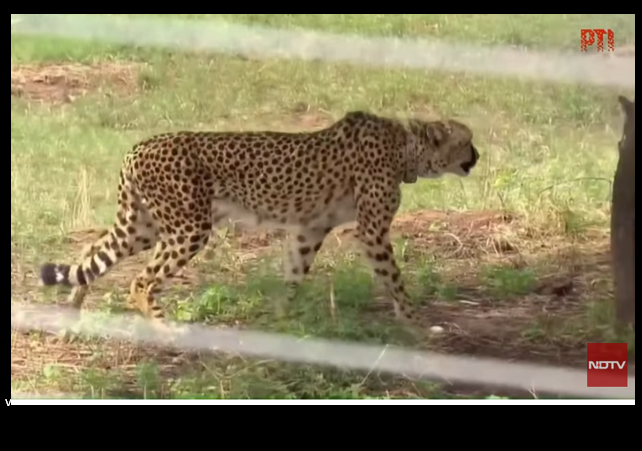Cheetahs Being Reintroduced to India, Thanks to South Africa and Conservation
Meanwhile, US Dept. of Interior offers workshops aim to help federal employees cope with ‘eco-grief’ to deal with all the environmental doom-casting.

After all the doom-casting about the environment and “the 6th Mass Extinction,” I thought I might offer some positive news that refutes the drama.
Thanks to conservation and real science, twelve South African cheetahs have begun a voyage to India as part of an intergovernmental agreement to reintroduce the big cats to India, where they have been extinct since the 1950’s.
They will join eight cheetahs from neighbouring Namibia that were released into the Kuno National Park in central India last year.
“The 12 cheetahs… have begun their journey to India,” India’s environment minister wrote on Twitter on Friday, adding they were expected to arrive on Saturday.
12 Cheetahs from South Africa on the way to India. Arrive in Madhya Pradesh's Kuno national park. pic.twitter.com/yPgvNsitJH
— Sidhant Sibal (@sidhant) February 17, 2023
South Africa will eventually ship about 100 of these big cats to India over the next decade.
The animals will end up in central India’s Kuno National Park, with protected areas home to rare and endangered animals. The cats are among the initial ones introduced in India under Project Cheetah, the first intercontinental translocation initiative of its kind.
The African cheetahs that will be arriving in India are not native to the region but the incoming cats belong to the genetically distinct African subspecies which diverged from its Asiatic cousin thousands of years ago.
The now-critically endangered subspecies, the Asiatic cheetah, originally roamed from the Arabian Peninsula to central India, but now only a handful of them remain in Iran and they thought to be inbred with questionable long-term viability.
There are many fun facts about cheetahs, such as they meow and purr rather than roar.
There’s nothing scary about the noises a cheetah makes. Unlike lions, which are known for their ferocious roars, cheetahs sound more like your average house cat. They meow and purr. They also make chirps and churring sounds. Listen to some of the chatty cheetahs from the Toronto Zoo.
There are four big cats that roar: lions, tigers, leopards, and jaguars. They are able to make their intimidating noises because they have a ligament instead of the epihyal bone in the voice box. The ligament stretches, creating lower sounds. Cheetahs have a fixed voice box with divided vocal cords. Like “small cats,” it allows them to purr but limits the noises they can make.
Meanwhile, in this country, The Interior Department’s Fish and Wildlife Service is offering “ecogrief” sessions for bureaucrats who are traumatized by all the aforementioned doom-casting.
The class will give staffers a chance to define what they mean by ecological grief, space to examine their emotional reactions and tools to grapple with those feelings, the agency said in a note to employees in the Southwest region, where the training is offered.
Those who sign up will be led to “find ways to act while caring for themselves.”
“This 4-hour workshop seeks to normalize the wide range of emotional responses that conservationists experience while empowering participants to act while taking care of themselves,” the notice said. “The workshop is intended for those experiencing ecological grief and for those who wish to support them.”
The amount of money, time, and resources being used to mollycoddle emotionally frail officials is shameful. The funding would be better spent on real science and successful conservation efforts, like that which is occurring with India’s new cheetahs.
Or, perhaps instead of going to workshops, those suffering from “eco-grief” can head over to Ohio and actively participate in the clean-up efforts. There are so many healthier options to self-indulgence.
 DONATE
DONATE
Donations tax deductible
to the full extent allowed by law.









Comments
I feel sorry for the Indians that did all of the work of eliminating a dangerous predator from their environment just to have a bunch of elitist globalist jerks put them back.
Cheetahs aren’t dangerous to humans. Ancient cultures used to tame them and use them for hunting.
I know a man who ran an endangered species sanctuary who had a cheetah in their house for a few years. They said it was just a big tame kitty
Yeah, that was my first thought — there’s nowhere in this article any indication that the Indian people as a “democratic entity” wanted cheetahs back.
Well, this will make waiting for the school bus a bit more interesting …
What is a cheetah’s diet, outside of the natives?
India actually has the proper mix of Bovidae (antelopes) and Cervidae (deer) to make perfect natural hunting.
But cows and sheep are easier to catch.
Let them re-introduce the Hippo next. Then things will get fun.
It’s much easier to hold a BS seminar than do the work. Another example of how the bureaucracy prioritize themselves over measurable improvements in their mission success and public service. Taxpayers exist to serve them. Our taxes are another resource to be extracted and shipped as tribute to an uncaring establishment class.
“Meanwhile, US Dept. of Interior offers workshops aim to help federal employees cope with ‘eco-grief’ to deal with all the environmental doom-casting.”
I don’t know about you, Leslie, but I personally don’t want animals saved by any organization that reeks of white supremacy, gets its pronouns wrong, or is blase about our impending eco-apocalypse.
/sarc
“… find ways to act while caring for themselves….”
More eyerolls that a barrel of Idaho spuds going 45 mph down a steep hill.
An Indian Cheetah is running for president.
Snort. Nicely done.